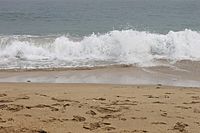Hancock County, Maine facts for kids
Quick facts for kids
Hancock County
|
||
|---|---|---|
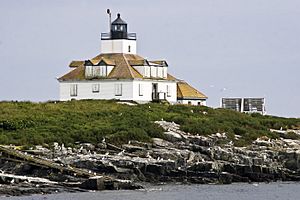
|
||
|
||
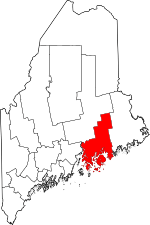
Location within the U.S. state of Maine
|
||
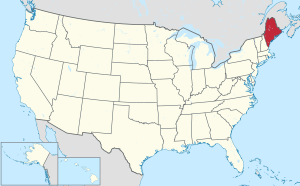 Maine's location within the U.S. |
||
| Country | ||
| State | ||
| Founded | June 25, 1789 | |
| Named for | John Hancock | |
| Seat | Ellsworth | |
| Largest city | Ellsworth | |
| Area | ||
| • Total | 2,345 sq mi (6,070 km2) | |
| • Land | 1,587 sq mi (4,110 km2) | |
| • Water | 758 sq mi (1,960 km2) 32%% | |
| Population
(2020)
|
||
| • Total | 55,478 | |
| • Density | 23.658/sq mi (9.1344/km2) | |
| Time zone | UTC−5 (Eastern) | |
| • Summer (DST) | UTC−4 (EDT) | |
| Congressional district | 2nd | |
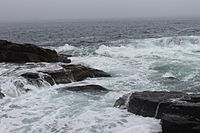
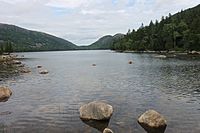
Hancock County is a county located in the U.S. state of Maine. As of the 2020 census, the population was 55,478. Its county seat is Ellsworth. The county was incorporated on June 25, 1789, and named for John Hancock, the first governor of the Commonwealth of Massachusetts. The Commissioners are William F. Clark, John Wombacher and Paul Paradis.
Contents
Geography
According to the U.S. Census Bureau, the county has a total area of 2,345 square miles (6,070 km2), of which 1,587 square miles (4,110 km2) is land and 758 square miles (1,960 km2) (32%) is water.
Adjacent counties
- Penobscot County, Maine — north
- Washington County, Maine — northeast
- Waldo County, Maine — west
Demographics
| Historical population | |||
|---|---|---|---|
| Census | Pop. | %± | |
| 1790 | 9,542 | — | |
| 1800 | 16,358 | 71.4% | |
| 1810 | 30,031 | 83.6% | |
| 1820 | 31,290 | 4.2% | |
| 1830 | 24,336 | −22.2% | |
| 1840 | 28,605 | 17.5% | |
| 1850 | 34,372 | 20.2% | |
| 1860 | 37,757 | 9.8% | |
| 1870 | 36,495 | −3.3% | |
| 1880 | 38,129 | 4.5% | |
| 1890 | 37,312 | −2.1% | |
| 1900 | 37,241 | −0.2% | |
| 1910 | 35,575 | −4.5% | |
| 1920 | 30,361 | −14.7% | |
| 1930 | 30,721 | 1.2% | |
| 1940 | 32,422 | 5.5% | |
| 1950 | 32,105 | −1.0% | |
| 1960 | 32,293 | 0.6% | |
| 1970 | 34,590 | 7.1% | |
| 1980 | 41,781 | 20.8% | |
| 1990 | 46,948 | 12.4% | |
| 2000 | 51,791 | 10.3% | |
| 2010 | 54,418 | 5.1% | |
| 2020 | 55,478 | 1.9% | |
| U.S. Decennial Census 1790–1960 1900–1990 1990–2000 2010–2016 2018 |
|||
2010 census
As of the 2010 United States census, there were 54,418 people, 24,221 households, and 14,834 families living in the county. The population density was 34.3 inhabitants per square mile (13.2/km2). There were 40,184 housing units at an average density of 25.3 per square mile (9.8/km2). The racial makeup of the county was 96.9% white, 0.8% Asian, 0.4% American Indian, 0.4% black or African American, 0.3% from other races, and 1.2% from two or more races. Those of Hispanic or Latino origin made up 1.1% of the population. In terms of ancestry, 24.0% were English, 19.8% were American, 15.2% were Irish, 9.0% were German, and 7.2% were Scottish.
Of the 24,221 households, 24.4% had children under the age of 18 living with them, 48.9% were married couples living together, 8.2% had a female householder with no husband present, 38.8% were non-families, and 30.3% of all households were made up of individuals. The average household size was 2.20 and the average family size was 2.71. The median age was 46.3 years.
The median income for a household in the county was $47,533 and the median income for a family was $60,092. Males had a median income of $41,046 versus $32,444 for females. The per capita income for the county was $26,876. About 6.8% of families and 11.5% of the population were below the poverty line, including 17.2% of those under age 18 and 7.3% of those age 65 or over.
Communities
City
- Ellsworth (county seat)
Towns
- Amherst
- Aurora
- Blue Hill
- Brooklin
- Brooksville
- Bucksport
- Castine
- Cranberry Isles
- Dedham
- Deer Isle
- Eastbrook
- Franklin
- Frenchboro
- Gouldsboro
- Great Pond
- Hancock
- Lamoine
- Mariaville
- Mount Desert
- Orland
- Osborn
- Otis
- Penobscot
- Sedgwick
- Sorrento
- Stonington
- Sullivan
- Surry
- Swan's Island
- Tremont
- Trenton
- Verona
- Waltham
Unorganized territories
Census-designated places
Other unincorporated villages
Economy
Of employed persons 16 years and over in 1990, 1,108 indicated involvement in the "agriculture, forestry and fisheries" industry, though 1,206 indicated "farming, forestry and fishing occupations." The U.S. Census data are not dependable for determining the numbers of individuals involved in the fishing industry. Only firms with 10 or more employees must report their numbers, as well as firms paying workmen's compensation insurance. Because the majority of fishermen in Maine are considered self-employed, the statistics underreport fishing employment.
Cranberry Isles, Deer Isle, Frenchboro, Gouldsboro, Southwest Harbor, Stonington, Swans Island and Tremont (Bass Harbor) were identified by a key respondent as fisheries dependent. Bar Harbor, Brooklin, Brooksville, Hancock, Lamoine, Mount Desert, Penobscot, Sedgwick, Sorrento and Sullivan were also noted as having either significant fishing activity or a significant number of people who fish. Winter Harbor's fishing activities were once dwarfed by the economic activity associated with a naval base, but now that the naval base has closed, fishing activity will most likely be the dominant economic activity in the community. Salmon farming is also popular in the area and Maine Salmon is an important export.
Hancock County has the longest coastline of any Maine county. Commercial fishing and tourism are the county's most important industries. Hancock County is home to Acadia National Park (the only national park in Maine or the New England region, excluding the national sea shore on Cape Cod) and Cadillac Mountain (the highest point in Maine's coastal region). Jackson Laboratory, noted for cancer research, is located in Bar Harbor. Two institutions of higher education are located in Hancock County: Maine Maritime Academy at Castine and the College of the Atlantic at Bar Harbor.
See also
 In Spanish: Condado de Hancock (Maine) para niños
In Spanish: Condado de Hancock (Maine) para niños




